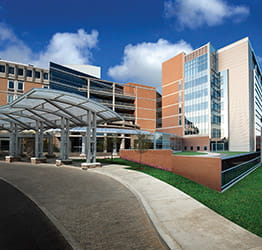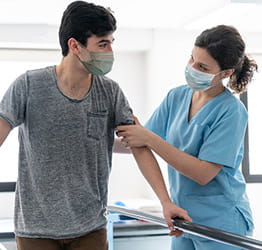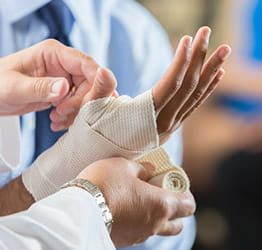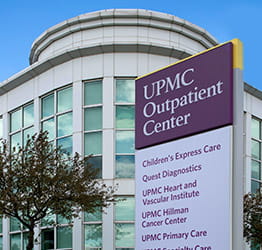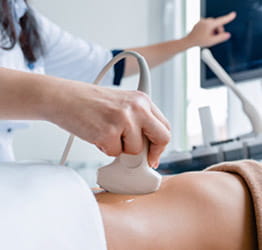On this page
What Is Ulcerating Breast Cancer?
Ulcerating breast cancer — also sometimes referred to as fungating breast cancer — is a rare condition that occurs when a breast tumor grows outward, breaking through the skin. This tumor creates an open wound that looks like a mushroom or cauliflower. Symptoms may include pain, odor, bleeding, and weeping fluid.
At what stage is ulcerating breast cancer diagnosed?
Ulcerating or fungating breast cancer is typically diagnosed when breast cancer reaches an advanced stage. It is usually diagnosed at stage 3 or 4, which means the tumor has spread to nearby lymph nodes, the chest wall, or skin, or metastasized (spread to other areas of the body).
What are the types of ulcerating breast cancer?
There are two types of ulcerating or fungating breast cancer:
- Primary ulcerating breast cancer — Caused by the original cancerous tumor.
- Secondary ulcerating breast cancer — Caused by a secondary breast tumor or a tumor that has spread to the breast from another part of the body.
Is ulcerating breast cancer treatable?
Yes. Ulcerating or fungating breast cancer treatment involves treating the cancer itself and treating the ulcerated skin with comprehensive wound care.
How common is ulcerating breast cancer?
Ulcerating or fungating breast cancer is rare, affecting 2% to 5% of people with locally advanced breast cancer.
What causes ulcerating breast cancer?
Ulcerating breast cancer occurs when cancer cells spread to the skin, causing the tissue to die from a lack of oxygen. This tissue death causes a skin ulcer or wound.
What are the risk factors and complications of ulcerating breast cancer?
Ulcerating breast cancer risk factors
You may be at higher risk of developing ulcerating or fungating breast cancer if:
- You have advanced breast cancer that has spread outside your breast or to another part of your body.
- You have had previous radiation treatment to your chest area.
- Your breast cancer has gone undiagnosed or untreated for a long time.
- Your breast tumor is large, aggressive, or can’t be surgically removed.
Complications of ulcerating breast cancer
Ulcerating or fungating breast cancer can cause serious complications, including:
- Depression and mental health challenges.
- Infection.
- Necrosis (tissue death).
- Odor.
How can I prevent ulcerating breast cancer?
You may not be able to prevent ulcerating breast cancer. However, getting routine breast cancer screenings can result in an earlier breast cancer diagnosis, which improves the chances of successful treatment and reduces your risk of complications.
If you notice any symptoms of breast cancer, schedule an appointment with your doctor as soon as possible and follow all testing and treatment recommendations.
Back to top
What Are the Signs and Symptoms of Ulcerating Breast Cancer?
Ulcerating or fungating breast cancer causes a cauliflower- or mushroom-like growth, an ulcer, or an open wound on your breast.
Other symptoms of ulcerating or fungating breast cancer include:
- Bleeding or drainage from the wound.
- Discolored skin.
- Foul odor coming from the wound.
- Painful or itchy skin.
- Signs of infection, including redness or swelling.
When should I see a doctor about my ulcerating breast cancer symptoms?
If you have ulcerating breast cancer symptoms, you should schedule an appointment with your doctor right away. If your symptoms are severe, you should go to the nearest hospital emergency department.
Back to top
How Do You Diagnose Ulcerating Breast Cancer?
To diagnose ulcerating or fungating breast cancer, your doctor will ask about your symptoms, perform a physical exam, and order imaging tests and a biopsy.
What to expect during your visit
If your doctor suspects ulcerating breast cancer, they will:
- Ask about your symptoms.
- Ask about your family history of breast cancer.
- Perform a physical exam.
- Order a biopsy to learn about the type of cancer you have.
- Order imaging tests.
- Review your health history and medications.
Tests to diagnose ulcerating breast cancer
Your doctor may order diagnostic imaging studies of your breast or other areas of your body, including:
- 3D mammogram (tomosynthesis) — A safe, noninvasive x-ray of your breast tissue. Your doctor may use computer-aided detection (CAD) software, which highlights abnormalities in your breast tissue.
- Chest x-ray — A painless, noninvasive test that creates an image of your chest and lungs.
- CT scan — A painless, noninvasive test that uses x-ray technology to capture multiple cross-sectional images of organs, bones, and tissues inside your body.
- Magnetic resonance imaging (MRI) — A safe, noninvasive imaging test that uses a magnetic field and radio waves to produce highly detailed images of breast tissue without radiation exposure.
- PET scan — Positron emission tomography (PET) is an imaging scan that shows abnormal cell activity within your body's tissues.
- Ultrasound (sonography) — A painless, noninvasive test that uses high-frequency sound waves to produce real-time pictures of your breast tissue.
Breast cancer biopsy and pathology testing
Your doctor may perform a biopsy to learn about the type of cancer you have. During a biopsy, your doctor will remove a sample of tumor tissue and send it to the lab for testing.
A doctor called a pathologist will perform tests to determine whether your cancer has HER2 proteins or hormone receptors. Your test results will give your doctor more information about the type of breast cancer you have, which will be used to guide your treatment.
Ulcerating breast cancer prognosis
Ulcerating or fungating breast cancer typically develops when a breast tumor is very large, aggressive, or has been left undiagnosed or untreated for a long time, which can make the cancer more challenging to treat.
In addition to treating the breast cancer itself, skin ulcerations also require wound care and can lead to other serious complications. Your doctor will discuss your prognosis with you.
Back to top
How Do You Treat Ulcerating Breast Cancer?
The goals of ulcerating or fungating breast cancer treatment are to remove or treat the cancer, heal the skin ulceration, and reduce the risk of recurrence.
Treatment options may include:
Surgery for ulcerating breast cancer
Surgery may be an option for ulcerating or fungating breast cancer.
Your doctor may recommend surgical procedures, including:
Breast cancer surgical procedures
- Lumpectomy — Also known as breast-conserving surgery or a partial mastectomy, a lumpectomy is a surgical procedure to remove the part of your breast with a cancerous tumor and some healthy surrounding tissue.
- Mastectomy — A surgical procedure to remove the entire breast. When both breasts are removed, it is known as a double mastectomy.
Lymph node surgical procedures
- Axillary lymph node dissection — Surgery to remove all or a group of lymph nodes in the axilla (armpit), if your sentinel lymph node biopsy is positive for cancer.
- Sentinel lymph node biopsy — A minimally invasive procedure to remove the sentinel (main) lymph node in the axilla (armpit) to test it for cancer. It is performed to determine if cancer has spread to your lymph nodes.
Radiation therapy for ulcerating breast cancer
Radiation oncology is a medical specialty that uses radiation therapy to kill cancer cells. Radiation therapy for breast cancer involves using high-energy x-rays to precisely target your tumor. It may be used after surgery or in combination with other therapies to treat ulcerated breast cancer.
Medical oncology for ulcerating breast cancer
Medical oncology for breast cancer involves using different types of anticancer medications to slow or stop breast cancer growth.
Your doctor may recommend treatments including:
Chemotherapy for ulcerating breast cancer
Chemotherapy is a breast cancer treatment that uses medications that travel through your bloodstream to kill cancer cells throughout your body. It may be used by itself or in combination with other treatments.
Your doctor may recommend chemotherapy:
- After surgery, to kill any remaining cancer cells.
- Before surgery to shrink the tumor so it can be removed more easily.
- If your cancer has spread to other areas of your body.
Hormone therapy for ulcerating breast cancer
Hormone therapy treatments block estrogen from fueling breast cancer growth and may also lower estrogen levels in your body.
Treatment options may include:
- Aromatase inhibitors (AIs) — Stop estrogen production in your body. Medications include letrozole, anastrozole, and exemestane.
- Luteinizing hormone-releasing hormone (LHRH) agonists — Prevent ovaries from making estrogen. Medications include goserelin and leuprolide.
- Selective estrogen receptor degraders (SERDs) — Used in post-menopausal women to prevent estrogen from connecting to cancer cells and break down estrogen receptors. Medications include fulvestrant and elacestrant.
- Selective estrogen receptor modulators (SERMs) — Used in pre-menopausal women to prevent estrogen from connecting to cancer cells. Medications include tamoxifen and toremifene.
Targeted therapy for ulcerating breast cancer
Targeted therapies work similarly to antibodies produced naturally by your immune system. These antibodies identify and attack foreign cells, including cancer cells. If ulcerated breast cancer cells have HER2 proteins, targeted therapy may be an option to slow or stop cancer growth.
Wound care for ulcerating breast cancer
In addition to treatment for the breast cancer itself, you will also need wound care to treat the skin ulceration.
Wound care treatment may include:
- Debridement or surgery to remove dead skin and tissue.
- Dressings and topical medications to keep the wound clean, control odor, improve comfort, and promote healing.
- Oral medications to treat or prevent infection.
Mental health care for ulcerating breast cancer
Ulcerating or fungating breast cancer causes a visible wound that can be physically uncomfortable and cause significant emotional distress. Your care team can help you manage the unique challenges of an ulcerated breast cancer diagnosis and refer you to a mental health professional who can help you cope with your condition.
Ulcerating breast cancer clinical trials
UPMC experts participate in national, multicenter clinical trials that study promising treatments for ulcerated breast cancer.
This means you can participate in research that has the potential to enhance breast cancer care and access groundbreaking treatments years before they become available to the public. Your doctor will let you know if a clinical trial might be an option for you.
Why choose UPMC for ulcerating breast cancer care?
When you choose UPMC for ulcerating or fungating breast cancer care, you will receive:
- Comprehensive breast cancer expertise — The breast cancer experts at UPMC provide state-of-the-art care for every form of breast cancer at every stage of the disease.
- Expert wound care — Our wound care doctors collaborate with your cancer care team to treat fungating breast cancer wounds.
- Personalized, collaborative care — Our surgical, medical, and radiation oncologists work together to plan the best course of therapy for you.
- Supportive services tailored to your needs — Our approach to breast cancer care honors your preferences by blending advanced clinical methods with supportive services for the best possible results.
Back to top
By UPMC Editorial Staff. Last reviewed on 2025-09-18.





